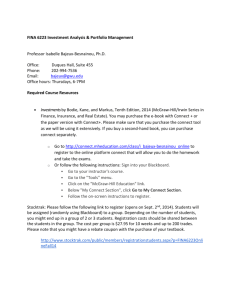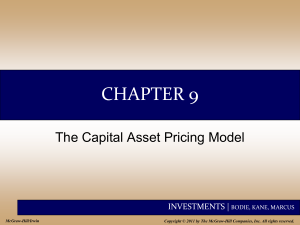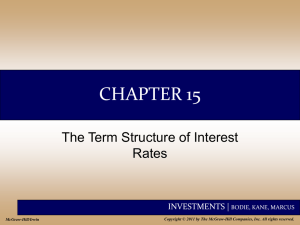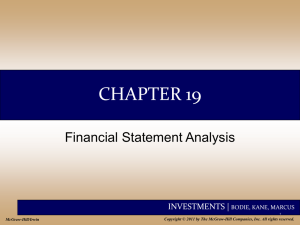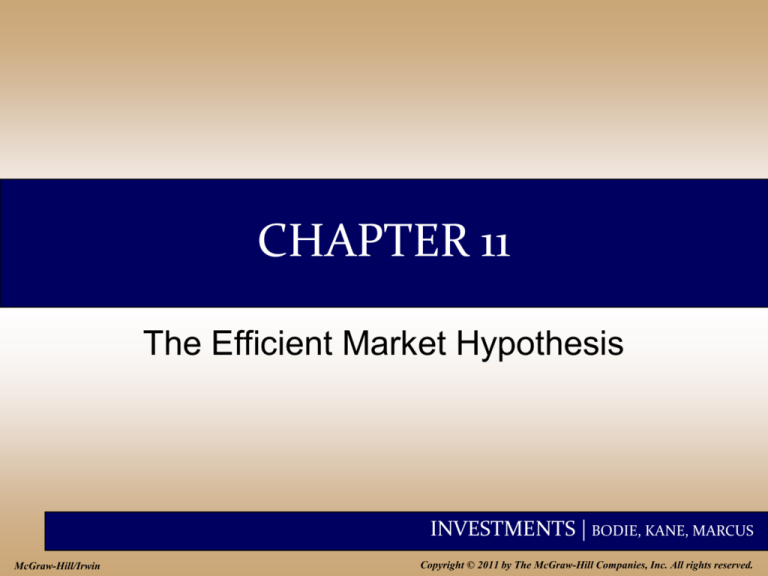
CHAPTER 11
The Efficient Market Hypothesis
INVESTMENTS | BODIE, KANE, MARCUS
McGraw-Hill/Irwin
Copyright © 2011 by The McGraw-Hill Companies, Inc. All rights reserved.
11-2
Efficient Market Hypothesis (EMH)
• Maurice Kendall (1953) found no
predictable pattern in stock prices.
• Prices are as likely to go up as to go
down on any particular day.
• How do we explain random stock price
changes?
INVESTMENTS | BODIE, KANE, MARCUS
11-3
Efficient Market Hypothesis (EMH)
• EMH says stock prices already reflect all
available information
• A forecast about favorable future
performance leads to favorable current
performance, as market participants rush
to trade on new information.
– Result: Prices change until expected returns
are exactly commensurate with risk.
INVESTMENTS | BODIE, KANE, MARCUS
11-4
Efficient Market Hypothesis (EMH)
• New information is unpredictable; if it
could be predicted, then the prediction
would be part of today’s information.
• Stock prices that change in response to
new (unpredictable) information also must
move unpredictably.
• Stock price changes follow a random walk.
INVESTMENTS | BODIE, KANE, MARCUS
11-5
Figure 11.1 Cumulative Abnormal Returns
Before Takeover Attempts: Target Companies
INVESTMENTS | BODIE, KANE, MARCUS
11-6
Figure 11.2 Stock Price Reaction to CNBC
Reports
INVESTMENTS | BODIE, KANE, MARCUS
7
The market discounts bad news right away…
INVESTMENTS | BODIE, KANE, MARCUS
11-8
When the settlement comes…
INVESTMENTS | BODIE, KANE, MARCUS
11-9
EMH and Competition
• Information: The most precious commodity
on Wall Street
– Strong competition assures prices reflect
information.
– Information-gathering is motivated by
desire for higher investment returns.
– The marginal return on research activity
may be so small that only managers of
the largest portfolios will find them worth
pursuing.
INVESTMENTS | BODIE, KANE, MARCUS
11-10
Versions of the EMH
• Weak
– All information on trading data (prices, open
interest, etc.) is already in the price
– No point in doing trend or technical analysis
• Semi-strong
– All publicly available information on
fundamentals is already in the price
• Strong
– Prices reflect all the information relevant to the
firm, including that only available to insiders
INVESTMENTS | BODIE, KANE, MARCUS
11-11
Types of Stock Analysis
• Technical Analysis - using prices and volume
information to predict future prices
• Examples: here
– Success depends on a sluggish
response of stock prices to fundamental
supply-and-demand factors.
– Weak form efficiency
• Relative strength
• Resistance levels
INVESTMENTS | BODIE, KANE, MARCUS
11-12
INVESTMENTS | BODIE, KANE, MARCUS
11-13
Technical Analysis on EURUSD
INVESTMENTS | BODIE, KANE, MARCUS
12-14
Candlestick Chart – definitions
INVESTMENTS | BODIE, KANE, MARCUS
12-15
Candlestick – Hi-Lo Sequence
Candlestick does not tell sequence
INVESTMENTS | BODIE, KANE, MARCUS
12-16
Candlestick Charts: Types
Trend vs
Consolidation
Marubozu = one
way action
INVESTMENTS | BODIE, KANE, MARCUS
12-17
Candlestick Analysis - Example
day open high low close
1 10 25 6
20
2 20
22 12 15
3 12 12
7
7
4
5
13 3
13
5
10 16 8
16
6
19 28 19 27
30
25
20
15
10
5
0
1
2
3
INVESTMENTS
4
5| BODIE, KANE,6MARCUS
12-18
A Football Analogy
Bulls
White jersey
Attack up
Game
direction
Bears
1. Bulls controlled most of the game
Black jersey 2. Bears controlled most of the game
Attack down 3. Neither team could move the ball
4. Bears controlled the ball for part of
the game, but lost control at the end
of the game, and the Bulls made an
impressive comeback
5. Bulls controlled part of the game, but
Bears made an impressive comeback
6. Both the Bears and the Bulls had
their moments during the game, but
neither could put the other away,
resulting in a standoff
INVESTMENTS | BODIE, KANE, MARCUS
11-19
Types of Stock Analysis
• Fundamental Analysis - using economic and
accounting information to predict stock prices
– Try to find firms that are better than everyone
else’s estimate
– Try to find poorly run firms that are not as bad
as the market thinks
– Semi strong form efficiency and
fundamental analysis: most of fundamental
analysis is doomed to fail
INVESTMENTS | BODIE, KANE, MARCUS
11-20
Active or Passive Management
• Active Management
– An expensive strategy
– Suitable only for very large portfolios
• Passive Management: No attempt to
outsmart the market (b/c you can’t)
– Accept EMH
– Index Funds and ETFs
– Very low costs
INVESTMENTS | BODIE, KANE, MARCUS
11-21
Market Efficiency & Portfolio Mgmt
Even if the market is efficient a role
exists for portfolio management:
• Diversification
• Appropriate risk level
• Tax considerations
INVESTMENTS | BODIE, KANE, MARCUS
11-22
Resource Allocation
• If markets were inefficient, resources
would be systematically misallocated:
– Firm with overvalued securities can raise
capital too cheaply
– Firm with undervalued securities may have to
pass up profitable opportunities because cost
of capital is too high
– Efficient market does not mean perfect
foresight market
INVESTMENTS | BODIE, KANE, MARCUS
11-23
Event Studies
• Empirical financial research enables us to
assess the impact of a particular event on
a firm’s stock price.
• The abnormal return due to the event is
the difference between the stock’s actual
return and a proxy for the stock’s return in
the absence of the event.
INVESTMENTS | BODIE, KANE, MARCUS
11-24
How Tests Are Structured
Returns are adjusted to determine if they
are abnormal.
Market Model approach:
• rt = a + b*rmt + et
(Expected Return)
• Abnormal Return = (Actual - Expected)
et = rt - (a + b*rMt)
Study Cumulative Abnormal Returns
INVESTMENTS | BODIE, KANE, MARCUS
11-25
Figure 11.1 Cumulative Abnormal Returns
Before Takeover Attempts: Target Companies
INVESTMENTS | BODIE, KANE, MARCUS
11-26
Are Markets Efficient?
• Magnitude Issue
– Only managers of large portfolios can
earn enough trading profits to make the
exploitation of minor mispricing worth it.
• Selection Bias Issue
– Only unsuccessful or partially successful
investment schemes are made public.
The really good ones will remain private.
• Lucky Event Issue (tossing coin, newsletter examples)
INVESTMENTS | BODIE, KANE, MARCUS
11-27
Weak-Form Tests
• Returns over the Short Horizon
– Momentum: Good or bad recent
performance continues over short to
intermediate time horizons (esp. portfolios)
• Returns over Long Horizons
– Episodes of overshooting followed by
correction
• Use of serial correlation
INVESTMENTS | BODIE, KANE, MARCUS
11-28
Predictors of Broad Market Returns
• Fama and French (more Fama here):
– Aggregate returns are higher with
higher dividend ratios
• Campbell and Shiller:
– Earnings yield can predict market
returns
• Keim and Stambaugh:
– Bond spreads can predict market
returns
INVESTMENTS | BODIE, KANE, MARCUS
11-29
Semistrong Tests: Anomalies
• P/E Effect (adjustment for risk?)
• Small Firm Effect (January Effect)
• Neglected Firm Effect, Liquidity Effects
• Book-to-Market Ratios (Fama-French)
• Post-Earnings Announcement Price Drift
INVESTMENTS | BODIE, KANE, MARCUS
11-30
Figure 11.3 Average Annual Return for 10
Size-Based Portfolios, 1926 – 2008
INVESTMENTS | BODIE, KANE, MARCUS
11-31
Figure 11.4 Average Return as a Function of
Book-To-Market Ratio, 1926–2008
INVESTMENTS | BODIE, KANE, MARCUS
11-32
Figure 11.5 Cumulative Abnormal Returns
in Response to Earnings Announcements
INVESTMENTS | BODIE, KANE, MARCUS
11-33
Strong-Form Tests:
Inside Information
• The ability of insiders to trade
profitability in their own stock has
been documented in studies by
Jaffe, Seyhun, Givoly, and Palmon
• SEC requires all insiders to
register their trading activity
INVESTMENTS | BODIE, KANE, MARCUS
11-34
Interpreting the Anomalies
The most puzzling anomalies are priceearnings, small-firm, market-to-book,
momentum, and long-term reversal.
– Fama and French argue that these
effects can be explained by risk
premiums.
– Lakonishok, Shleifer, and Vishney
argue that these effects are evidence
of inefficient markets.
INVESTMENTS | BODIE, KANE, MARCUS
11-35
Figure 11.6 Returns to Style Portfolio as a
Predictor of GDP Growth
INVESTMENTS | BODIE, KANE, MARCUS
11-36
Interpreting the Evidence
• Anomalies or data mining?
–Some anomalies have
disappeared.
–Book-to-market, size, and
momentum may be real
anomalies.
INVESTMENTS | BODIE, KANE, MARCUS
11-37
Interpreting the Evidence
• Bubbles and market efficiency
–Prices appear to differ from
intrinsic values.
–Rapid run up followed by crash
–Bubbles are difficult to predict
and exploit.
INVESTMENTS | BODIE, KANE, MARCUS
11-38
Stock Market Analysts
• Some analysts may add value, but:
– Difficult to separate effects of new
information from changes in investor
demand
– Findings may lead to investing
strategies that are too expensive to
exploit
INVESTMENTS | BODIE, KANE, MARCUS
11-39
Mutual Fund Performance
• The conventional performance benchmark
today is a four-factor model, which employs:
– the three Fama-French factors:
• return on the market index
• return based on size
• return based book-to-market ratio
– plus a momentum factor (a portfolio
constructed based on prior-year stock
return)
INVESTMENTS | BODIE, KANE, MARCUS
11-40
Figure 11.7 Estimates of Individual Mutual
Fund Alphas, 1993 - 2007
INVESTMENTS | BODIE, KANE, MARCUS
11-41
Mutual Fund Performance
• Consistency, the “hot hands”
phenomenon
– Carhart – weak evidence of persistency
– Bollen and Busse – support for
performance persistence over short time
horizons
– Berk and Green – skilled managers will
attract new funds until the costs of
managing those extra funds drive alphas
down to zero
INVESTMENTS | BODIE, KANE, MARCUS
11-42
Figure 11.8 Risk-adjusted performance in
ranking quarter and following quarter
INVESTMENTS | BODIE, KANE, MARCUS
11-43
So, Are Markets Efficient?
• The performance of professional
managers is broadly consistent with
market efficiency
• Most managers do not do better than the
passive strategy
• There are, however, some notable
superstars:
– Peter Lynch, Warren Buffett, John Templeton,
George Soros (how about Bernie Madoff?)
INVESTMENTS | BODIE, KANE, MARCUS

